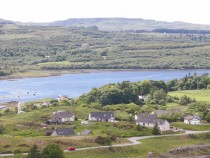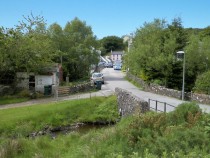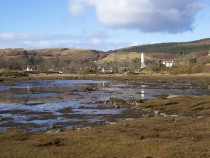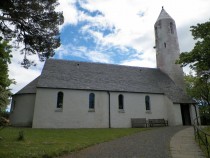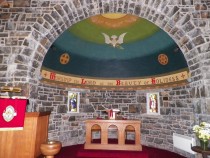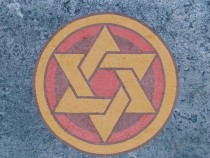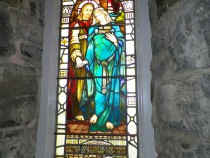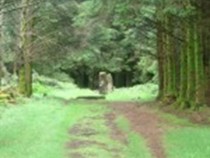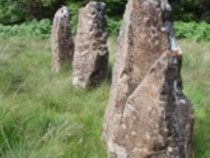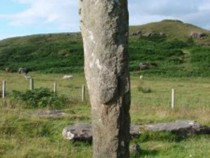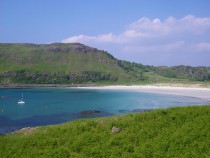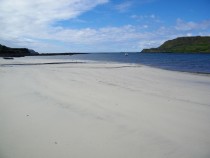Dervaig's name derives from Viking origins meaning "good inlet"in the old Norse language,and indeed this is very true with Dervaig lying inland at the head of sheltered sea Loch a' Chumhainn (narrow loch). The settlement at least goes back to the 1200s when the first church was built. Dervaig (pronounced locally Dervig) sits at a crossroads and is found from four different directions:Calgary from the north west,Tobermory from the east ,Salen from the south,and Torloisk hill road from the west. All routes are single track with passing places and all are extremely scenic. In the middle of October on one weekend these roads are used for The Mull Car Rally, one of a kind in the UK as public roads are used for the rally and are closed off at certain times during the weekend. Ask John for the specific rally dates and times if you are staying at Seaview over this weekend and wish to travel to the north of Mull. The main road to Seaview and Iona is not affected.
The older houses in Dervaig's bonnie main street, approximately 26 of them were part of a planned village established by Alexander MacLean of Coll in 1799. The Dervaig area is a crofting township community where old smallholding land laws prevail , one of two on Mull, the other one being in the south on the Ross of Mull around Bunessan 5 miles from Seaview. The village today has a busy shop and post office, a historic cattle drovers inn,The Bellachroy Inn, the oldest inn on Mull founded in 1608,and on the outskirts on the Torloisk road,The Old Byre Heritage Tea Room providing interesting history and tasty home baking. At Penmore on the Calgary road there is a pleasant restaurant using fresh local seafood and other produce called Am Birlinn.
Kilmore Church
Grid Reference NM 431 518
However the " jewel in the crown" of the Dervaig area is the enchanting Kilmore Church read more with its striking white harled 63 foot high pencil tower and unusual gentle, simple interior. Kilmore Church was designed by architect Peter MacGregor Chalmers (who also worked on Iona Abbey restoration around this time) and completed in 1905, replacing the previous church on the same site which was built in 1755. The church before this date was the old parish church of Kilcolmkill, the ruins of which are in the old graveyard on the hill rising to the east above the village at the side of the Tobermory road
On the outside the charming simple lines has been noted by some as Romanesque in character which was typical of the times and in particular the Arts and Craft Movement in Scotland of which the architect was an exponent of. The tower design was taken from Irish Watchtowers design such as Enniskillen. There are only two other towers of this type in Scotland similar to the Dervaig tower.
On entering the church you are at once pleasantly surprised of how unusual and bright the interior is is compared to other west coast Church of Scotland churches.There is a simple serene feel to this space
. The frequent use of wood, unusual colours and grey and red stone blocks create a beautiful peaceful image in the eye of the
beholder. There are two dominating features inside the church.Firstly the unusual apse at the east end. Highly decorated, with bright colours and interesting symbols, a feature of peaceful beauty and great originality. So original at the time of opening it caused one devout church goer to resign from the church in protest at the idolatrous image painted on the ceiling.
Secondly, there are seven beautiful stained glass windows made by Stephen Adam a famous Glasgow stained glass artist of the times. Adam often worked in conjunction with Chalmers. Again elaborate stained glass in a country Church of Scotland church is such an unusual feature.
One of the stained glass windows is of particular interest. Dedicated to Mary Forrest of Ardow erected by her sister Isabella and signed by Adam in 1905. In the official description "Christ holds the hand of a calm Madonna blue gowned, Mary who holds her left hand over her heart. For the alternative ideas and descriptions! read more
Standing Stones around Dervaig
On the hill to the east of Dervaig where the road to Tobermory zig zags up the hill, on one of the bends at the top there is a small car park and
approximately 200 metres north west from here is the site of The Kilmore or Cnoc Fada Standing Stones. The stones are situated in a grassy glade guarded by a coniferous pine forest, there is a signposted rough path to the stones from the car park. There are five standing stones, two standing 2.5 metres high and 3 lying down in the grass. From the Kilmore Standing Stones there is a path going deeper into the forest for approximately half a mile, when you will come to another set of 3 standing stones in a clearing below Maol Mor Crag. There are also 3 standing stones at Dervaig cemetery downhill on the road below the aforementioned car park on the outskirts of Dervaig.
Another location near Dervaig has standing stones. To reach the Quinish Stones, take the road north through Dervaig Village and along the loch and just before the entrance to Quinish Estate there is a parking place on the right. From here follow the path on foot for a mile. There are four stones aligned NNW-SSE only one remains standing today and is over 9 feet high. The stone is known locally as "Caliach" or "old woman" as from a certain angle it looks like an old woman in a cloak!
The late Robert Pollock minister in Salen produced a brilliant detailed website with drawings of Mull's Standing Stones, Stones of Wonder
Stone photos courtesy of isle of mull net
The Old Byre.
Heritage Centre situated in beautiful Glen Bellart close to Dervaig. Films and exhibition about the history of Mull and its people and its abundant and varied Geology, wildlife flora and fauna on land and on the water! There is a gift shop and tearoom serving light lunches and cracking home baking.
Calgary and its famous Beach
Calgary or Cala Ghearraidh (Beach of the Meadow) is located 5 miles from Dervaig on the north west of Mull, the Bay faces west to the Atlantic and The Isle of Coll. Its famous powder white sand beach with its typical west highland machair is at the head of the bay surrounded by gentle wooded hills. An area of abundant and diverse bird life, rocky cliffs, mystic ancient forts and abandoned ruined townships ideal for an adventure! There is a pier to the west of the beach on the north shore which used to serve the now ruined original township of Inivea which became uninhabited at the time of the Highland Clearances. The pier was built for puffers to deliever coal and supplies for the village and the Mornish Estate and to ship sheep to the Treshnish Isles for summer grazing. Todays hamlet is above the beach to the north situated around Calgary farmhouse, where there is the Calgary Carthouse Tearoom and a lovely woodland walk with orchid meadow at the top and wood sculptures on the path to the beach.
Calgary in Canada takes its name from Calgary on Mull. Colonal MacLeod of the Canadian Mounted Police had a summer home in Calgary Castle on Mull and returning home one year he suggested a Fort in Alberta be named Calgary, hence today Calgary, Alberta! The castle sits in the woods in an elevated position above the beach. It has an nineteenth century gothic castellated facade which can be seen from the beach, the house behind is older built in the 1700s and was a typical Scottish Lairds Hoose!
For alternative information on this area visit www.isle- of- mull.net

